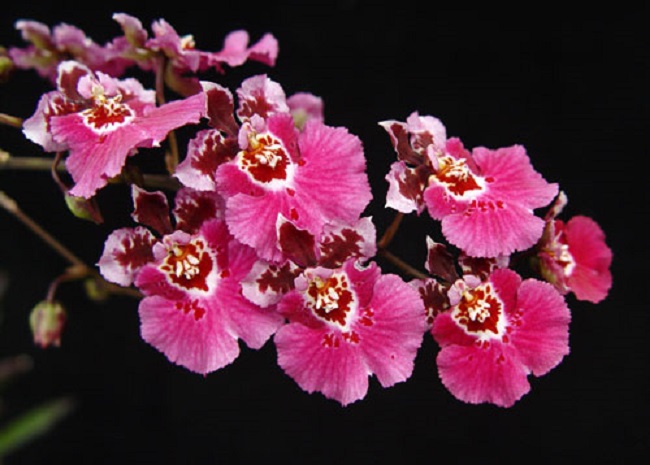
Oncidium orchids, commonly referred to as “Dancing Lady” orchids, are renowned for their vibrant and showy blooms. With their diverse colors and delightful fragrance, Oncidium orchids have become a popular choice among orchid enthusiasts. While these exotic beauties may seem delicate, they are relatively easy to care for, making them suitable for both novice and experienced growers. In this article, we will explore the basic care requirements for Oncidium orchids, enabling you to nurture these stunning plants and enjoy their graceful dance of flowers.
Light Requirements
Proper lighting is crucial for the healthy growth and blooming of Oncidium orchids. They thrive in bright, indirect light, like the light conditions found under a shade cloth. A location near an east or west-facing window, where the orchid receives morning or late afternoon sun without direct exposure, is ideal. If natural light is insufficient, supplement with fluorescent or LED grow lights placed about 12 to 18 inches above the plants.
Temperature and Humidity
Oncidium orchids prefer moderate to warm temperatures. They thrive in daytime temperatures between 70°F and 85°F with nighttime temperatures dropping slightly. Adequate ventilation is essential to prevent the buildup of excess heat and humidity. Maintain a humidity level around 50 to 70 percent, which can be achieved by placing the orchid on a humidity tray filled with water or using a room humidifier.
Watering and Moisture
Proper watering is vital. They prefer a semi-dry growing medium, so it’s important to avoid overwatering. Allow the potting medium to dry out slightly between waterings, and then water thoroughly. Ensure good drainage to prevent waterlogged roots, which can lead to root rot. As a general guideline, water Oncidium orchids every 5 to 7 days during the active growth phase and reduce watering frequency during their rest period.
Potting Medium and Repotting
Oncidium orchids are epiphytes, naturally growing on trees and deriving nutrients from the air and rainwater. Therefore, they require a well-draining potting medium that mimics their natural habitat. A popular choice is a mixture of orchid bark, sphagnum moss, and perlite. Repotting should be done every 1 to 2 years, preferably in spring or early summer when new growth emerges. Use this opportunity to examine the roots and remove any dead or decaying portions.
Fertilization
Regular feeding is essential to support the growth and flowering of Oncidium orchids. Use a balanced orchid fertilizer, diluted to half the recommended strength, and apply it every 2 to 4 weeks during the active growing season. During the resting period, reduce or suspend fertilization to allow the plant to rest.
Air Circulation and Ventilation
These orchids thrive in environments with good air circulation. Stagnant air can lead to the development of fungal and bacterial diseases. Ensure proper ventilation in the growing area by using fans or opening windows to create a gentle breeze. This not only prevents diseases but also helps to maintain optimal temperature and humidity levels.
Pest and Disease Control
While Oncidium orchids are generally resilient, they can occasionally encounter pests such as aphids, mealybugs, and spider mites. Regularly inspect your plants for any signs of infestation and take appropriate measures, such as using insecticidal soap or horticultural oil, to control pests. Additionally, maintaining good cultural practices, such as proper watering and ventilation, helps prevent the occurrence of common orchid diseases like root rot.
9 Fun Facts About Oncidium Orchids
The Dancing Lady
Oncidium orchids are often referred to as “Dancing Lady” orchids due to the distinctive shape of their flowers. The petals and sepals resemble a dancing lady with a skirt, capturing the elegance and charm of these blooms.
Lots of Diversity
Oncidium is a large genus of orchids, comprising over 300 species. They exhibit a wide range of colors, patterns, and sizes, offering a diverse selection for orchid enthusiasts.
Fragrant Blooms
Many Oncidium orchids produce delightful fragrances that can range from sweet and citrusy to spicy and chocolate-like. The fragrances are often more pronounced in the evenings, attracting pollinators such as moths.
Epiphytic Nature
Like many orchids, Oncidiums are epiphytic plants. In their natural habitats, they often grow on trees or other plants, using their aerial roots to anchor themselves while absorbing moisture and nutrients from the air and rainwater.
Hybridization Success
Oncidium orchids are widely hybridized, resulting in a vast array of cultivars and hybrids. These hybrids often combine desirable traits from different species, such as vibrant colors, intricate patterns, and increased flower longevity.
Blooms That Last
The flowers of Oncidium orchids have impressive longevity compared to some other orchid species. Depending on the variety, the blooms can last anywhere from several weeks to a few months, providing extended periods of visual delight.
Bee Mimicry
The shape and coloration of Oncidium orchid flowers often resemble bees, serving as a clever adaptation to attract male bees for pollination. Male bees, tricked into thinking they are approaching a potential mate, visit the flowers and inadvertently transfer pollen.
Native Habitats
Oncidium orchids are found in diverse habitats across the Americas, from rainforests to cloud forests and even dry scrublands. They are native to regions such as Central America, South America, and the Caribbean.
Symbolism
Orchids, including Oncidiums, hold symbolic meanings in various cultures. They are often associated with love, beauty, and luxury, and are frequently used in floral arrangements, weddings, and special occasions.
Related Articles & Free Email Newsletter Sign Up
How to Care for Phalaenopsis Orchids Before and After Blooming




Comment here